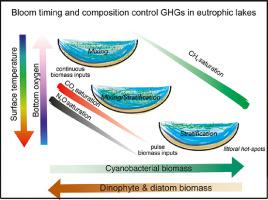Water Research ( IF 11.4 ) Pub Date : 2021-02-27 , DOI: 10.1016/j.watres.2021.116985 Maciej Bartosiewicz , Roxane Maranger , Anna Przytulska , Isabelle Laurion

|
Lakes are important sources of greenhouse gases (GHGs) to the atmosphere. Factors controlling CO2, CH4 and N2O fluxes include eutrophication and warming, but the integrated influence of climate-warming-driven stratification, oxygen loss and resultant changes in bloom characteristics on GHGs are not well understood. Here we assessed the influence of contrasting meteorological conditions on stratification and phytoplankton bloom composition in a eutrophic lake, and tested for associated changes in GHGs inventories in both the shallow and deep waters, over three seasons (2010-2012). Atmospheric heatwaves had one of the most dramatic effects on GHGs. Indeed, cyanobacterial blooms that developed in response to heatwave events in 2012 enhanced both sedimentary CH4 concentrations (reaching up to 1mM) and emissions to the atmosphere (up to 8 mmol m−2 d−1). That summer, CH4 contributed 52% of the integrated warming potential of GHGs produced in the lake (in CO2 equivalents) as compared to between 34 and 39% in years without cyanobacterial blooms. High CH4 accumulation and subsequent emission in 2012 were preceded by CO2 and N2O consumption and under-saturation at the lake surface (uptakes at -30 mmol m−2 d−1 and -1.6 µmol m−2 d−1, respectively). Fall overturn presented a large efflux of N2O and CH4, particularly from the littoral zone after the cyanobacterial bloom. We provide evidence that, despite cooling observed at depth during hot summers, CH4 emissions increased via stronger stratification and surface warming, resulting in enhanced cyanobacterial biomass deposition and intensified bottom water anoxia. Our results, supported by recent literature reports, suggests a novel interplay between climate change effects on lake hydrodynamics that impacts both bloom characteristics and GHGs production in shallow eutrophic lakes. Given global trends of warming and enrichment, these interactive effects should be considered to more accurately predict the future global role of lakes in GHG emissions.
中文翻译:

富营养化湖泊中浮游植物水华对温室气体通量和排放的影响
湖泊是大气中重要的温室气体(GHG)来源。控制CO 2,CH 4和N 2 O通量的因素包括富营养化和变暖,但是人们对气候变暖分层,氧气损失和随之而来的开花特性变化对温室气体的综合影响尚不十分了解。在这里,我们评估了富营养化湖泊中不同气象条件对分层和浮游植物开花组成的影响,并测试了三个季节(2010-2012年)浅水区和深水区温室气体清单的相关变化。大气热波对温室气体影响最大。实际上,响应2012年热浪事件而产生的蓝藻水华增强了沉积CH的作用。4种浓度(达到1mM)和向大气的排放(高达8 mmol m -2 d -1)。那个夏天,CH 4贡献了湖泊中温室气体综合变暖潜能的52%(以CO 2当量计),而没有蓝藻水华的年份则为34%至39%。在2012年高CH 4积累和随后的排放之前,湖面CO 2和N 2 O消耗和饱和度降低(在-30 mmol m -2 d -1和-1.6 µmol m -2 d -1处吸收,分别)。跌倒倾覆呈现N 2大量流出O和CH 4,特别是在蓝细菌开花后的沿海区域。我们提供的证据表明,尽管在炎热的夏季在深处观察到降温,但由于较强的分层和表面变暖,CH 4排放增加,导致蓝藻生物量沉积增加和底水缺氧加剧。我们的结果得到最新文献报道的支持,表明气候变化对湖泊水动力的影响之间存在新颖的相互作用,既影响浅水富营养化湖泊的水华特征和温室气体产生。考虑到全球变暖和富集的趋势,应考虑这些相互作用的影响,以更准确地预测湖泊在温室气体排放中的未来全球作用。











































 京公网安备 11010802027423号
京公网安备 11010802027423号